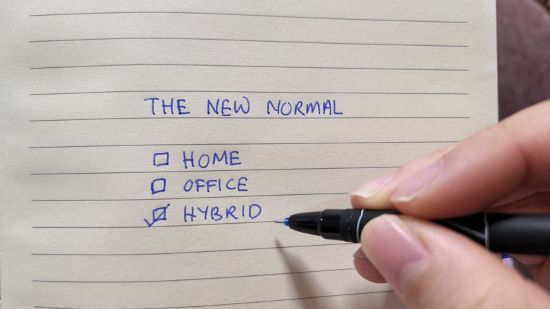Please welcome back Andrew Olsen to the 21st Century Tech Blog. Andrew previously wrote about the merits of video gaming as skill-building and learning exercises. He, himself is a gamer.
In this posting he describes how hybrid work may contribute to a healthier work-life balance.
I would like to add a personal observation on this subject having worked for more than a decade from home as a full-time, part-time employee and independent consultant running my practice. I often worked during off-office hours putting in 10 to 12-hour days. I spent more time learning about clients, better understanding their needs, and delivering solutions to them that sold themselves. I spent far less time in meetings and dealing with office politics.
I found I had more time for my family. I was able to go for walks with my dogs to clear my mind before getting back to the job. I was physically more active. At the same time, my wife will tell you that I filled my dedicated home office space with charts and strategies pinned to the walls, planning calendars, and a personal menagerie of technologies to support the work. In the end by working from home part-time I was more productive, more engaged, and produced better results.
Whereas I cannot account for other’s experiences it would be good to hear from those who work from home full or part time. It would be great to hear from digital nomad readers. All your comments are welcome.
The COVID-19 pandemic accelerated a global shift in how we work leading to the widespread adoption of hybrid work models where employees split their time between working from home and being in the office.
This model, which once seemed temporary, has become a permanent operational business model for many industries. As of 2023, approximately 70% of North American companies have adopted some form of hybrid work with millions of employees enjoying the flexibility it offers.
This shift has also given rise to the “digital nomad” lifestyle, where workers leverage technology to perform their jobs from any location, blurring the lines between work and personal life. While the flexibility of hybrid work is appealing, it also presents new challenges, particularly in maintaining a healthy work-life balance.
As more employees navigate this new landscape, the impact on their physical and mental health has come into sharper focus. Blurred boundaries can lead to increased stress, a sedentary lifestyle, and challenges from being disconnected from the workplace. Technology is stepping in, however, to help manage these aforementioned challenges with tools and resources.
Wellness Apps: A Holistic Approach to Health
Wellness apps support users of mobile phones and computing devices to achieve and maintain better physical and mental health. They include fitness, nutrition, sleep, and mental health management exercises and monitoring to integrate wellness into daily routines.
Physical Health Apps – include workout plans, step counters, and move reminders to address physical health. They are particularly beneficial for those who spend long hours at a desk by encouraging regular physical activity breaks, reducing the risk of sedentary-related health issues. Many offer personalized fitness programs that adapt to a user’s schedule and fitness level.
Mental Health Apps – provide stress management and mindfulness tools. Guided meditation sessions, breathing exercises, and mood-tracking exercises help hybrid workers manage the stress of balancing multiple responsibilities. They are especially useful for creating moments of calm during or after a busy and long workday.
Fitness Trackers: Staying Active and Motivated
Fitness trackers are useful for anyone looking to stay healthy. That’s what makes them particularly valuable to those doing hybrid work. These are wearable devices that monitor physical activity, heart rate, sleep patterns, and more. They provide real-time data.
Fitness trackers are portable and convenient. Use them to remind you to move, track your steps, and provide gentle nudges to get you to stand up and stretch during long sitting periods. They can prevent the common pitfalls of a sedentary work lifestyle, such as weight gain, decreased energy levels, and poor posture.
Beyond basic activity tracking, many fitness trackers offer advanced features like sleep analysis and stress monitoring. You can use them to optimize sleep routines and identify periods of heightened stress. They can inform users about when to take breaks or adjust their workload.
Using Data to Enhance Wellness
Biohacking is defined as a do-it-yourself approach to wellness involving changes to habits and behaviours. Wearable technology can enhance biohacking to help fine-tune health routines and enhance overall well-being while advising safe practices and minimizing risk.
Biohacking wearables collect and analyze biometric data including monitoring blood sugar levels, tracking sleep cycles, measuring heart rate variability, and even analyzing nutrition intake. Data collected provides insights into how your body responds to different activities and environments and allows hybrid workers to adjust their routines to ensure they are operating at their best and in safety.
For example, if data from a wearable device shows that stress levels spike during certain times of the day, a hybrid worker might use this information to schedule breaks, incorporate stress-relief techniques, or adjust their workload to avoid burnout. Similarly, monitoring nutrition intake through a biohacking app can help a hybrid worker get the right balance of nutrients, particularly when juggling work and home life demands.
Biohacking apps and technology empower hybrid workers through personal health data, allowing them to optimize physical and mental performance to align with their unique needs and lifestyles.
Virtual Health Platforms
Virtual health platforms are digital healthcare delivery services for those who work remotely. Typically they include telemedicine video consultation, secure messaging, a secured and private electronic health record, appointment scheduling, and electronic prescriptions and medication tracking. They provide an invaluable convenience for hybrid workers.
Instead of taking time off work for medical help, appointments can be scheduled to fit personal circumstances. Virtual accessibility is important for managing chronic conditions, mental health issues, and routine check-ups ensuring that healthcare remains a priority even in a busy work environment. Virtual health platforms offer continuity of care for easier follow-ups. They provide a fully integrated continuum that saves time, enhances quality of care, and gives patients a comprehensive view of their health and future needs regardless of where and when they are working.
Embracing Technology for a Healthier Work-Life Balance
Is hybrid work becoming the new norm? In a recent Gallup poll, 8 of 10 remote-capable employees stated they expected to work this way or go fully remote in the future. A recent Fortune article noted that 82% of Fortune 500 companies are offering workplace flexibility allowing employees 2 to 3 days per week to work from home. It increasingly is being viewed as the future of work and the new normal.
For those who do hybrid work, therefore, the challenge of maintaining a healthy work-life balance is becoming more relevant than ever. Technology in the form of wearable devices and apps can serve hybrid workers to navigate the challenges presented by this new work-life paradigm.
From wellness apps that support physical and mental health to fitness trackers that keep workers active and motivated, to biohacking technology that offers personalized health insights, and virtual health platforms that provide convenient access to care, a growing suite of tools is available to help hybrid workers stay healthy and satisfied.
What About the Health of Employers?

Pushback from employers against hybrid work models has been growing in government and companies as they look at empty desks and office space and want to fill it (see image above). They, too, need to consider wellness apps and stop using unfounded concerns about declining collaboration and productivity per employee as justification. The Canadian and U.S. governments are among many including major employers like Apple, Amazon and Meta who want to put the genie of hybrid work back in the bottle.
Younger workers responding to these efforts to force them back into offices full-time are indicating their displeasure by changing jobs. They have been learning to value the work-life balance benefits more than being compelled and ordered to return to the office which they see as onerous and a betrayal of trust by their employers.
A recent Stanford University study of working-from-home professionals headed up by Professor Nicholas Bloom, from the School of Humanities and Sciences and a senior fellow of the Stanford Institute for Economic Policy, concludes that the pushback to compel workers to return to the office has little foundation. Its findings show that work-from-home employees who do this two days per week are just as productive, less prone to quit, and as likely to get promoted as those who come to the office full-time.
Bloom notes after four years of the COVID-19 pandemic that upended how and where people do their jobs, hybrid work has proved to be a “win-win for employee productivity, performance and retention.” Reduced attrition is saving companies millions, even those staring at expensive and empty office real estate.
For hybrid work employees, work-life balance is seen as a benefit that is worthwhile even if it involves a pay cut.









